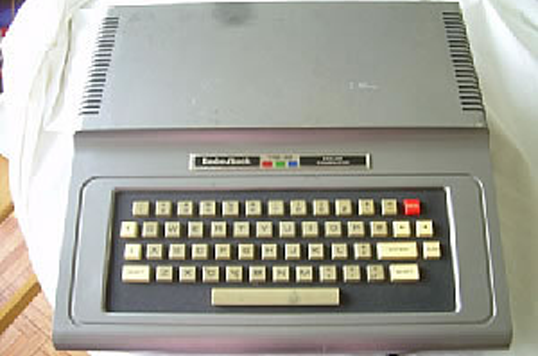Not Hardly…
Greetings retro fans! I hope everyone is enjoying the holiday season. When we left off last month, we had just finished a discussion on the differences between the TRS-80 Z-80 based systems and the CoCo. Entire volumes could be written if we wanted to compare the architecture and design philosophy between the systems. For that discussion, I’ll throw the ‘boring flag’ right now on that discussion, as it’d probably only interest engineers. Besides, a Model I, III, IV guru I am not, and when you get right down to it, there are plenty of differences between the CoCo models themselves to write about.
Below are the technical specs for the Color Computer upon it’s birth in 1980:
- CPU: 8 bit 6809E
- Clock speed: 0.89 MHz
- Bus type: Tandy Proprietary
- Data bus width: 8 – bit
- Address bus width: 16 – bit
Memory
- Standard on system board 4K (early models) or 16K
- Maximum on system board 32k (early models) or 64K
- Maximum total memory 64K
- ROM: 8K expandable to 16K
Misc. Features
- Ports: RS232C serial ports, Mouse/joystick (shared), 40 pin expansion slot
- Display Screen size: 32 X 16
- Resolution: 9 / 256 X 192
- Storage : Tape and Floppy
- Operating System: Microsoft basic ver 1.1
Brief synopsis on model numbers:
The first CoCo to be released was model number 26-3001 with 4 K of ram (later upgraded to 16k). These can easy be identified in the wild by the TRS label on the left hand side and a small “4k” or “16K bubble on the top right hand side.
Known Model Numbers include:26-3001- 4K RAM with Color Basic, 26-3002- 16K RAM with Extended Color Basic
The second style, with larger release numbers, was the Center Label style and did not have a RAM badge on the top case. These units were ether 16 or 32 K.
Known Model numbers include: 26-3002A, 26-3003, 26-3004, 26-3004A, 26-3004B.
The very first TRS-80 Color Computer carried the 26-3001 model number. The machine was released in a battleship gray plastic case, with an 8K Microsoft BASIC interpreter (in ROM), chiclet keyboard and a whopping 4K of RAM. Upon release, the very first CoCo 1 had a suggested retail price of $399. Like many home computers of the day, the CoCo shipped with a TV modulator to hook it up to your television. The display was a 32 x 24 black characters on a ‘nuclear green’ background. The CoCo also sported a 53 key ‘keyboard’, joystick, cassette and serial ‘bit banger’ ports on the back, as well as a 40 pin expansion slot on the right side.
Early versions of the CoCo could be upgraded to 32K, however, it was not an easy task as it required piggybacking two banks of 16K memory chips and adding a few jumper wires. Later revisions to the motherboard eliminated this upgrade. In fact, I have a 26-3001 (picture below) that was upgraded to 32K and Extended Color BASIC by a place in Davenport, Iowa. The 32K upgrade consists of eight socketed MN4164-15 dynamic RAM chips, and two jumper wires.
Later motherboard revisions removed the 4K RAM option; systems were upgraded to 32K with 64K memory chips which were supposed to be ‘half bad’ as a cost-cutting measure. The boards have jumpers marked HIGH/LOW to determine which half of the memory chip was good. The BASIC programmer was none the wiser, since in either configuration, 32K of memory was available.
The 26-3002 & 26-3003 models looked alike and were basically the same hardware; really the only difference in them was the amount of RAM � 16K and 32K respectfully. As memory production yields improved and costs went down, it’s rumored that many, if not most 32K CoCo 1s were shipped with perfectly good 64K memory chips. In fact, clever coders began to write utilities and programs to take advantage of this ‘extra’ 32K.
Eventually the 32K CoCo was dropped entirely and only 16K or 64K versions were offered. All versions of the CoCo which shipped with just Microsoft Color BASIC could be upgraded to Extended Color BASIC by simply plugging a ROM into an empty socket provided on the motherboard. ECB offered many enhancements to the BASIC interpreter, making it much easier to program than most other computers of the day.
Below are two machines from my collection:
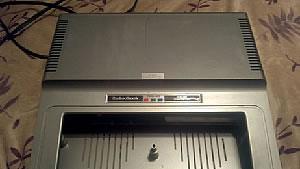
This unit is a 26-3004 – one of the last generation CoCo1s. It has 64K, and as purchased from eBay, had a CoCo3 keyboard. Notice the case-mod from the very poor packing the seller did.

This unit is a 26-3001 – first generation CoCo1. It has a 32k upgrade and an aftermarket keyboard. I’m not sure of the model of the keyboard, but, I think it’s a Mark Data SuperPro keyboard. It has a really good feel to it and is easy to type on.
It’s easy to see the cosmetic differences between the two models. The outside isn’t the only place where differences existed. As stated earlier, Radio Shack made numerous changes to the CoCo1 motherboard throughout its production run. As I understand it, there are seven different revisions to the PCB, the last one being referred to as the ‘F’ board.
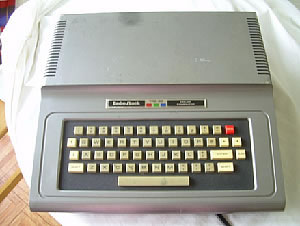
The TRS-80 Color Computer models 26-3002 and 26-3003:
The second generation Color Computer models are easily spotted: The TRS-80 nameplate is centered above the keyboard, and there is no ‘RAM button’ mounted to the top case. Additionally, the keyboard surround is no longer flat black.
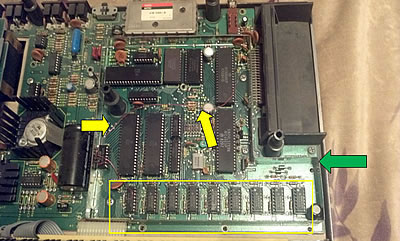
Above is the motherboard of the 26-3001. Notice the jumper wires (yellow arrows) added to complete the 32k upgrade. Also, for comparison to the 26-3004 picture coming up, pay close attention to the layout of the board. That green arrow points to the outline of the RF shield the CoCo1s were sportin’ back in the ’80s. Those are the SDRAM chips in the yellow box, taking up some real-estate.
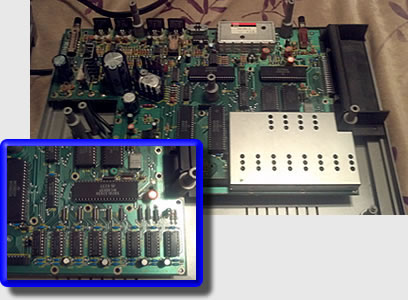
Here’s the 26-3004 motherboard. Notice the difference in the layout ? They’re the same machine, run the same software and use the same hardware and peripheral devices; advancements in the manufacturing process lead to a more optimized PCB.
The area underneath the RF shield (highlighted in blue), where the SDRAM chips reside, is much more compact and no more jumpers.
The White CoCo
That about tells the story for the CoCo1. However, I’d be remiss if I didn’t mention the 26-3003b CoCo model – CoCo the White. Okay, so it doesn’t sound as impressive as ‘Gandalf the White’, but, it IS a 64K CoCo1 built into a white case, with the bonus of an improved keyboard. Ironically, many still scratched their heads at this keyboard since it looks like someone put it in an oven and melted the keys. Seriously. It’s still referred to as ‘the melted keyboard’ by CoCo fans world-wide.
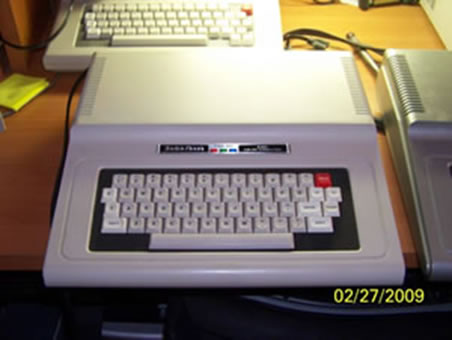
The TRS-80 Color Computer model 26-3003b:
The second generation Color Computer sold in a white case with a funky ‘melted’ keyboard. As with the other 26-3002 & 26-3003 lines, the TRS-80 nameplate is centered above the keyboard, and there is no ‘RAM button’ mounted to the top case. This model was sold only with 64k RAM. About this time Radio Shack also offered peripheral devices in white as well. I purchased this unit off of eBay in 2008 for $42.00. Still don’t even know if it works.
The Clone Wars…
Well… I guess I’m not yet done with the CoCo1. You see, Radio Shack, in its infinite wisdom, decided the CoCo was such a success they should attempt to duplicate its sales volume in another venue… department stores. Regardless of the venue, it’s still a CoCo1. In a tan case. With vents all across its back. And a chiclet keyboard.
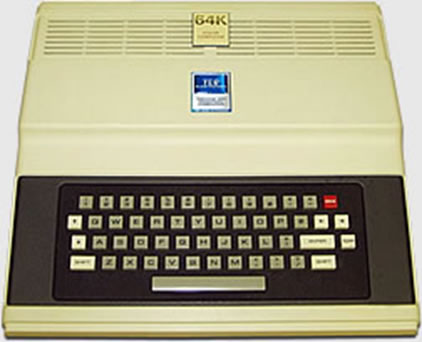
The TDP-100 was sold only with 64K of RAM, and Microsoft’s Extended Color BASIC was standard, ran all CoCo1 software and used the same CoCo accessories.
For a more in depth look at the CoCo1 line, Glen VanDenBiggelaar did a complete tear-down of a CoCo 1 (and 2 and 3), and posted it at his CoCo Lounge site back in 2005. Unfortunately he passed away a few years ago, and his site and information is lost.
Dragons and computers?
Whew… that’s a lot of CoCo 1 options. What’s that? More CoCo’s? You’re kidding, right? Um.. no. Well, sort of. Maybe. There was a clone of the CoCo that began production in 1982 by Dragon Data, LTD.; a Welsh company. They developed the Dragon32, which was a clone of the CoCo with several improvements, the most obvious being the keyboard. This computer was mainly marketed in the U.K.

The Dragon 32 was more or less CoCo compatible. There are caveats to that since the keyboard map is somewhat different. Also, you could use CoCo floppy drives, if you had the Dragon Disk BASIC ROM for the controller. A later version of the Dragon, the Dragon 64, contained 64K of RAM and a real serial/RS-232 (the CoCo has a bit banger port). Other than that, there were very few differences between the Dragon 32 and 64. During the run of the Dragon computers, multi-industry company Tano decided to get into the computer marketing business, and struck a deal with Dragon Data to bring the Dragon line to the U.S. with the Tano Dragon nameplate. Due to a number of flubs regarding software and missed release dates, the Dragon never really took off in the States.
Are we done yet…?
There are two more CoCo clones out in the wild, that deserve mention here. The first one I’ll mention is the Prologica CP-400 (below left). While its case design was an attractive, yet radical departure from the afore mentioned machines, its internals were not. My next statement might be predictable, but, I’m going to say it anyway; I don’t think I’d like typing on that keyboard…
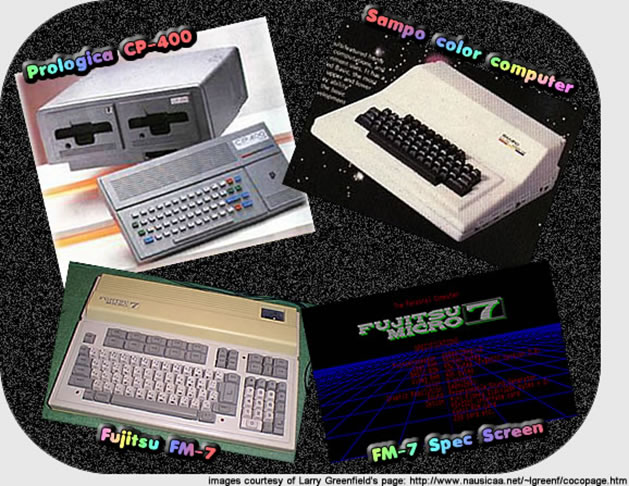
Above right, we have the Sampo color computer. As you can see, it’s… different. Not much is known about the beast, except it has same basic feature the original CoCo, with the addition of true lowercase characters and a REAL keyboard; both lacking in the original CoCo. Well, I cannot speak for the other computers of the day, however, the TRS-80 Color Computer was represented by several variations of its own. When you include the clones, it becomes easier to understand why the CoCo was confused with so many other model – quite literally, it had lots of siblings. And clones…
Now imagine my surprise, considering I just thought I had finished this article, when I realized I left out one other extended family member of the CoCo – the Fujitsu FM-7. I’m including it here because it is somewhat CoCo compatible – rumored to be the equivalent of a CoCo 1/2; on steroids. These Japanese made 8-bitters were actually rocking two 68B09’s; one for a CPU, the other to handle graphics. They could run Microware’s OS-9 operating systems, as well as Frank Hogg’s FLEX OS. If you’re interested, you can get MUCH more information from Larry Greenfield’s web page, as there’s more info there than is appropriate for this article series.
Doing the research for much of this article, as well as some business obligations, kept me from having the time I needed to write any reviews of some CoCo games as I had planned. In lieu of that, I’ll give a link to Curtis Boyle’s web site of CoCo gaming. The following are pictures of some CoCo games I’ll be reviewing in the future. They come from Curtis’ web site:

This was obviously a clone of Donkey Kong; it also had all four screens – a claim many systems that had licensed versions couldn’t make.

This game is called Qiks, and is a clone of the arcade game Qix, I remember being quite addicted to this game.

This Popeye clone, called Sailor Man was an outstanding game and had all of the elements of its arcade counterpart.
In closing, I’d like to give you a glimpse of next month’s article – which is part three, and focuses on the CoCo2. It’ll be a much shorter article, so I should have time to do an actual game review for a change. For February’s issue, I’ll be discussing the CoCo3, what made it different from the other models, and its special modes.
Thanks to L. Curtis Boyle for allowing the use of the images above from his website.

